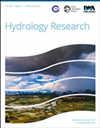典型温带至干旱气候中的基流指数特征:概念分析和模拟实验,以评估气候强迫特征和集水区地质环境的相对作用
IF 2.4
4区 环境科学与生态学
Q2 Environmental Science
引用次数: 2
摘要
低流量水文特征对于高效开发和水资源综合管理至关重要。其中,基本流量指数“BFI”是最重要的低流量指数之一。许多研究表明,它与几个地形参数、气候、植被和土壤类型以及集水区地质有关。为了增强对气候和集水区特性对“BFI”的相对控制的了解,采用了一种由经验分析组成的方法,该方法适用于意大利南部的一个以典型地中海环境为特征的大面积地区,随后在泛欧范围内进行了模拟实验,考虑到气候环境,典型的温带到干燥气候。主要研究结果表明:(i)在年尺度上,“BFI”和降水量之间的相关性结构受到气候变化和集水区特性的影响;(ii)“BFI”变异性受到气候年内和年间变异性的强烈制约;(iii)然而,主要作用被分配给地质集水区特征,排水不良和排水良好的集水区在应对类似的气候变化时表现不同。本文章由计算机程序翻译,如有差异,请以英文原文为准。
Baseflow index characterization in typical temperate to dry climates: conceptual analysis and simulation experiment to assess the relative role of climate forcing features and catchment geological settings
Low-flow hydrological features are crucial for efficient development and integrated water resources management. Among others, the BaseFlow Index ‘BFI’ is one of the most important low-flow indices. Many studies have demonstrated that it is related to several topographic parameters, climate, vegetation and soil types and to catchment geology. With the aim to enhance the knowledge about the climate and catchment properties’ relative control on the ‘BFI’, an approach consisting of an empirical analysis, applied to a large area located in Southern Italy, characterized by a typical Mediterranean environment, is followed by a simulation experiment, considering climate settings, at the pan-European scale, typical of temperate to dry climate regimes. Main findings have revealed that (i) the correlation structure between the ‘BFI’ and the precipitation volume, at the annual scale, is affected by both climate variability and catchment properties; (ii) the ‘BFI’ variability is strongly conditioned by climate intra- and inter-annual variability; (iii) the major role is, however, assigned to the geological catchment features, with poorly and well-drained catchments behaving differently in response to similar climate forcing variability.
求助全文
通过发布文献求助,成功后即可免费获取论文全文。
去求助
来源期刊

Hydrology Research
Environmental Science-Water Science and Technology
CiteScore
5.30
自引率
7.40%
发文量
70
审稿时长
17 weeks
期刊介绍:
Hydrology Research provides international coverage on all aspects of hydrology in its widest sense, and welcomes the submission of papers from across the subject. While emphasis is placed on studies of the hydrological cycle, the Journal also covers the physics and chemistry of water. Hydrology Research is intended to be a link between basic hydrological research and the practical application of scientific results within the broad field of water management.
 求助内容:
求助内容: 应助结果提醒方式:
应助结果提醒方式:


